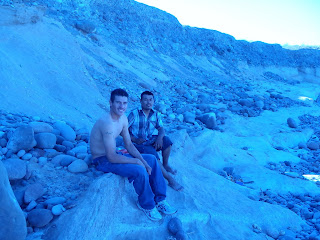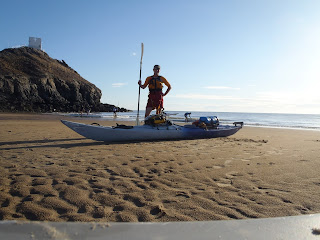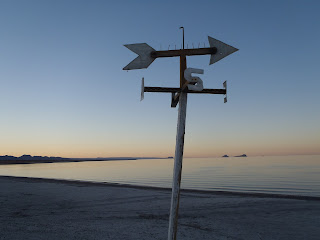On 5 May we loaded up the truck and headed for the border. We crossed at Tecate and it may have been the easiest border crossing I have ever had. We drove up to a gate, the light turned green, the gate went up, and we were in Mexico. There were 2 soldiers off to the side talking to each other but basically no one even looked at us or checked anything coming across. It was more like driving into a parking garage then an international border. We managed to drive to a town called Santa Thomas that first day to a campground that had a restaurant across the street. That was the most expensive accommodation of the road trip - 200 pesos which is $16.67. For some reason every time I enter Baja it rains the first day. It was raining the morning I started the paddle and it rained that night on us in Santa Thomas. From then on it was solid blue skys, white fluffy clouds, and very warm. We then cranked out miles for the next two days to get to La Paz as quickly as possible. There is a 2 lane paved highway that goes all the way there that is in pretty good condition though it is narrow with no shoulder. If you drop a wheel off the side of the road you would be in trouble pretty quickly. The drive was very scenic with sweeping vistas of mesas, valleys, arroyos, both the Pacific and Sea of Cortez, and a variety of cactus and elephant trees.
We reunited with my Mom in La Paz who had been having her own little adventure meeting people. We spent 2 nights there recovering from the road burn before it was time to send my Mom off at the airport and to head off on our own to explore the peninsula. We also started to run together to prepare for this summer of major ultra running. I had been sitting in a kayak for 2 months so I was not in running shape but I was heat acclimated. Kathleen had been running some but she was not used to the heat. This evened us out pretty nicely so we remain good training partners for each other. Initially we headed down to Todos Santos and then Cabo San Lucas. We didn't really want to see the tourist sprawl of Cabo but since we were that far south we figured we should touch the southern end of Baja. Todos Santos was a nice little town that has an artsy Carmel feel to it and Cabo wasn't quite as bad as I expected. I had expected it to be like Cancun which it was but not as big.
Driving back north was when the one hiccup of the entire trip occurred. We were driving back north through the outskirts of La Paz when I was pulled over by the Municipal Policia. I was speeding by 15 or more miles per hour but really was just going with the flow of traffic. I was singled out because we were gringos with American plates and two giant kayaks on the roof. The cop took my drivers license and registration and then told me that he was going to hold on to them for security because I had to go downtown to the police station to pay the fine which was 12000 pesos or $100. My Spanish which is not good in the first place became much worse on purpose when he pulled me over. I explained (in English) that if I went to the police station it would mean that I would have to drive at night to get where I was going and that was very bad. I also told him that I would have to put the fine on a credit card since I didn't have that much cash (that was a lie). He then asked "How much cash?". I told him I would go check, went up to the cab of my truck (we were talking next to his cruiser), quickly took most of the money out of my wallet and stashed it under some stuff, and then walked up to him and showed him that I only had 500 pesos ($40) in my wallet. He decided that was enough, gave me my documents back, and on our way we went. I obeyed the speed limit much more strictly when we were in towns after that. It also made me wish that there was a way to bribe the red light cameras in Seattle. A $40 bribe is way better then a $140 red light show up in the mail ticket. I think this experience has made me a little more pro-corruption.
Driving north we spent some time in Puerto San Carlos on Magdalena Bay which is where the grey whales come to have their babies. By the time we got there they had already left except for one juvenile who everyone thought was sick and likely dying. It ended up being too windy while we were there so we never did put the kayaks in the water.
We then went and spent a few days in Mulege. It had been one of my favorite spots on the paddle and Kathleen also fell in love with it. We camped on the beach next to the El Patron restaurant/bar and did some running. We also had lunch at Bahia Coyote which is a gorgeous beach on Bahia Concepcion. We met all sorts of cool characters while hanging out here. Many of the ex-pats we met (both American and Canadian) think that the bad publicity Mexico is currently getting is a conspiracy plot by the corporate media to keep American retirement and tourist dollars within the U.S.
Just outside Mulege was Punta Chivato. We drove up there and looked up Russ again who had been very hospitable to me when I paddled through. I am voting Russ's house as "Best place in Baja to show up unannounced". Our timing was great because he was due to drive up to San Diego the next day. He was hanging out with his friend Carol who ended up being Kathleen's "soul sister". Lots of things in common from growing up overseas to similar careers. We drank several bottles of wine before driving to a nearby beach and spending the night. Another huge thanks to Russ for showing us a good time and for all the food he gave us to eat for the next few nights.
We then drove into the desert and camped out in the Valle de los Cirios to do some trail running. Actually for parts of it there was no trail but the desert provides a great environment to just run cross country until we hooked up with some ATV/4WD roads. The elephant trees were like something out of a Dr Suess book and made a neat landscape to run through. Our runs gradually were becoming longer and harder as we started to feel a little more in shape.
From there we cut back to the Sea of Cortez on a "primary rural route" which means that it was a pretty rough dirt road where the fastest you could really go without beating up your vehicle (and the kayaks on the roof rack) was about 15mph. We drove to Gonzaga Bay for an incredibly windy night and then from there got back on paved roads to San Felipe (where the paddle had begun) and then back to the United States. Crossing the border wasn't that difficult. We got into the wrong line which turned out to be one of the fast lanes. Even though we didn't have the correct preauthorized card to be in that line they did not yell at us. They tried to trick me with the question "What do you do for a living?" and then let us through. We probably got through the line 45 minutes to an hour faster then we would have if we had been in the "correct" line.
We then spent a few days crossing Arizona. Beautiful desert runs in Kofa National Wildlife Refuge and then Sedona which Kathleen absolutely fell in love with. We ran up Mt Wilson which was our hardest run yet. Kathleen ran past a rattlesnake. I was following her so by the time I got to the snake it was pissed off, coiled, and ready to strike. Luckily I heard its rattle over my I-Pod and stopped in time. Despite being in deserts lots of times this was the first rattlesnake I had ever seen. We then also spent a day exploring Petrified Forest National Park before driving to Durango.
We spent a week in Durango. My Mom and brother live there. Both Kathleen's parents and my Dad flew out to see us off. It was a time to visit family and friends, sort through gear and pack, explore some of the territory around Durango, get some runs in, and my nephew Elias was in a baseball tournament that his team won. It was a good week but very busy.
The last week of World Tour Prologue was in Boulder. We flew there from Durango. One of the rougher flights I have had. There was wind shear going on in Denver so we had to make multiple attempts to land while the plane bucked around. Multiple people got sick including the guy sitting next to us. Kathleen even fanned him with the Emergency Instructions card to try to help him feel better. The week in Boulder was another crazy week trying to cram in as many friends as we could. We watched the elites run the Boulder Boulder. It is amazing how fast they go. We were on bikes and shortcutting the course and even then could barely keep up with them. More runs, happy hours, Farmers Market, and ending up the week with a Postal Service concert at Red Rocks rounded out the week. A big thanks to Krissy for letting us crash at her house.
Next stop is Iceland for 7 days before going to Ireland to see family and explore the Emerald Isle.












.JPG)

.JPG)


.JPG)
.JPG)
.JPG)

.JPG)
.JPG)

.JPG)

.JPG)







.JPG)



.JPG)
.JPG)


.JPG)



.JPG)

























